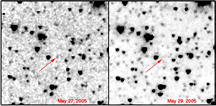
Heat generated from a gamma-ray burst has been detected for the first time by a team of astronomers led by University of Notre Dame physicist Peter Garnavich.
Using the Spitzer Space Telescope in rapid response mode, the team spotted the expanding energetic explosion produced by a burst of gamma-rays in a unique wavelength band.
Spitzer looked atGRB 050525a(named by the date it was discovered, May 25, 2005) with all three of its detectors May 27, just two days after the burst was identified by Swift, another NASA satellite designed to study GRB from gamma-ray wavelengths to visible light.
The light from gamma-ray burst afterglows fades quickly, so Spitzer had to move fast to catch the burst before it disappeared from view.
The controllers of the Spitzer telescope really jumped on this burst as soon as we let them know this was a good one,Garnavich said.They did a great job in getting observations just 48 hours after discovery.
The Spitzer Space Telescope is sensitive tothermal-infraredwavelengths, the same type of energy you feel when placing your hand near the burner of a hot stove. Most of the photons from a GRB afterglow come out in the infrared, making this an important region to study. But until Spitzer, the gamma-ray bursts could not be spotted in the mid-infrared.
You, me, telescopes, the air, they all have a temperature so they all glow in the infrared, putting ground-based telescopes at a big disadvantage,Garnavich said.
Gamma-ray bursts are huge blasts of energy visible across large distances in the universe. Research by the same team in 2003 showed that some gamma-ray bursts come from the death of massive stars in a supernova explosion. The explosion is signaled by a short burst of gamma-rays that are then often accompanied by an afterglow of light, X-rays and radio waves which last for just a few hours to a few days. The spasms of light burn with the brilliance of 10 billion suns as a narrow jet of particles, traveling nearly at the speed of light, runs into slow gas surrounding the star.
Scientists speculate that if gamma-ray bursts are caused by the collapse of massive stars, it may be possible to use them to trace star formation in the early universe.
These observations open up a new and important window on gamma-ray bursts that fills in the gap between the optical and radio work from the ground,Garnavich said.
Other members of the research team include: Kevin Krisciunas, Notre Dame; Kris Stanek and Michael Pahre, Harvard-Smithsonian Center for Astrophysics; David Bersier, Space Telescope Science Institute; Stephan Holland, Goddard Space Flight Center; Alberto Noriega-Crespo, Caltech/Spitzer Science Center; Rosalba Perna, University of Colorado; and Thomas Matheson, National Optical Astronomy Observatories.
The Jet Propulsion Laboratory (JPL) manages the Spitzer Space Telescope mission for NASAs Science Mission Directorate,Washington,D.C.Science operations are conducted at theSpitzerScienceCenterat the California Institute of Technology inPasadena. JPL is a division of Caltech.
* Contact: * Peter Garnavich, professor of physics, 574-631-7262, pgarnavi@miranda.phys.nd.edu .
TopicID: 11682